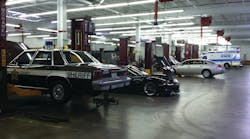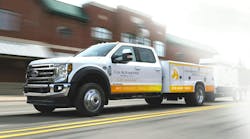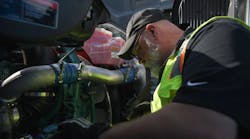Bob Nolen can’t say exactly how much the eastern Pennsylvania school bus operator Transportation Services has saved through smart parts management, but he does say the benefits are self-evident. With $200,000 to $300,000 of inventory – including tires – at any given time, the company’s fleet and facility manager says his inventory includes virtually no obsolete parts, and he always knows its total value within a few dollars.
But one element of parts management is more quantifiable than others. Nolen says the fleet saves between $10,000 and $15,000 a year on core returns and warranty recovery, and his light duty vehicles are very much a part of the program.
Headquartered in Souderton, PA, Transportation Services runs school buses through the northern suburbs of Philadelphia. Their coach division operates more than 20 motor coaches on regular tours and charters throughout the U.S. and Canada, including Alaska.
The immaculately kept, 201-unit fleet includes 18 minibuses, 42 vans and seven other light duty units – exactly one-third of the total. The minibuses and vans are used almost exclusively for special-needs school transportation.
PARTS CONTROL
Parts management was a problem when Nolen joined the company in 1990. For one thing, inventory was tracked on paper. But that began to change in 2000 when he replaced legacy maintenance management software with the Dossier application from Arsenault Associates (www.arsenault.com), a provider of fleet maintenance management software. Parts control is built into the system.
Nolen soon added barcoding and later a Symbol Technologies (www.symbol.com) wireless handheld computer and scanner that talks to the Dossier database.
“Barcoding all your parts allows you to do an inventory any time,” he points out. “You can scan a barcode in the parts room and check your inventory count. If you’re doing a major cleanup and moving parts around, you can pull up a part and change its location right then and there.”
Barcoding also makes it easier to manage warranty recovery and core returns. For Transportation Services, the process begins with the purchase order.
“When I double-click on that part number, it opens a purchase order and assigns a purchase order number at that point,” says Nolen.
GREEN FOR WARRANTY
When a part is received and put in the system, Dossier asks: “Do you want to print a barcode label?” Labels, which that can be printed in batches to save time, will show exactly where the part should be stored on the parts room shelves, Nolen explains.
“When we receive a part that’s under warranty, we make up a warranty label. Let’s say it's a minibus that’s under warranty and we need to replace a bad part. The part gets labeled like everything else, but it also gets a warranty barcode and a bright green warranty sticker to go on the incoming box. So, the technician knows that when he puts this part on, he needs to put the old part back in this box.”
That's because the faulty part needs to go back for warranty credit, he adds. The manufacturer wants the original part back, of course, often to return to the original parts vendor.
“Our vehicle histories tell us if a part has failed within a warranty period. Say a van is two years old. We know when a replacement part comes in that the original is probably under a manufacturer's warranty.”
The value to the fleet is often free part replacement or cash credit.
YELLOW FOR CORE RETURN
Returnable cores also represent opportunities to recover cash. Core credits are usually available if you have paid a core charge for a part, say an alternator, observes Nolen.
That core charge is similar to an old-fashioned bottle deposit. Return the bottle and get 5 cents back.
Like returned soda bottles, cores are reusable. A spent alternator, for example, can be rebuilt and sold.
“We return core brake cylinders, calipers, starters and even axles from our light duty vehicles,” he says.
“If we receive a part that has a core charge, the old part gets sent back. The new part gets a barcode label that’s printed out for core value. It goes on the new part box.
“We also put a yellow sticker on it that says 'Core.' The technicians know that box does not get thrown out. The old part goes back in that box and is returned for credit.”
Many suppliers provide invoice credits for returned cores, he notes. “Credits can range anywhere from $10 to $1,000.”






